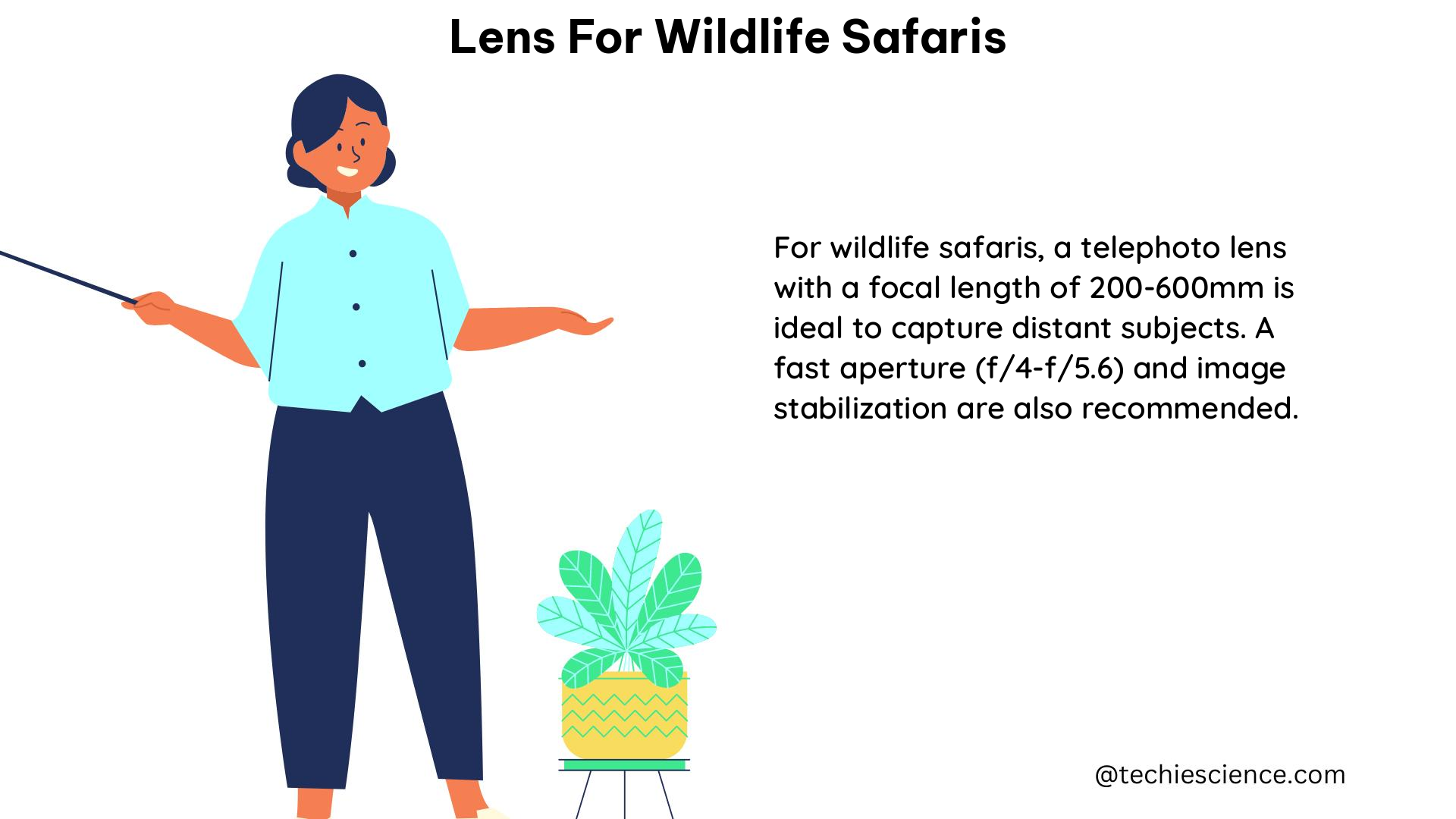When it comes to capturing the breathtaking moments of a wildlife safari, the choice of lens can make all the difference. As a seasoned expert on lens selection for wildlife photography, I’m excited to share my insights and technical expertise to help you make the most informed decision for your next safari adventure.
Understanding Focal Length and Zoom Range
The recommended focal length range for wildlife safaris typically spans from 200mm to 600mm, with some photographers even opting for longer focal lengths to capture distant animals. The key reason for this is the need to maintain a safe distance from the wildlife while still being able to frame your shots effectively.
A longer focal length, such as 600mm, allows you to capture detailed, close-up shots of animals without disturbing them. This is particularly important when photographing skittish or endangered species, as it minimizes the risk of startling them and disrupting their natural behavior.
On the other hand, a shorter focal length, such as 200mm, can be useful for capturing wider, contextual shots that include the animal’s environment and surrounding landscape. This can help to tell a more comprehensive story and provide a sense of the animal’s habitat.
To strike the perfect balance, a zoom lens is generally preferred over a fixed lens. Zoom lenses offer greater flexibility in framing and composition, allowing you to seamlessly transition between wide-angle and telephoto shots as the situation demands.
Lens Recommendations for Wildlife Safaris

Now, let’s dive into some specific lens recommendations and their technical specifications:
1. Canon RF 100-500mm f/4.5-7.1L IS USM
- Focal Length Range: 100-500mm
- Aperture Range: f/4.5-7.1
- Image Stabilization: Yes, Optical Image Stabilization (IS)
- Minimum Focusing Distance: 3.12 feet (0.95 meters)
- Maximum Magnification: 0.33x
- Filter Size: 77mm
- Weight: 3.03 pounds (1.37 kg)
This versatile lens from Canon offers a wide zoom range, making it an excellent choice for wildlife safaris. The optical image stabilization (IS) feature helps to reduce camera shake, ensuring sharper images, even when shooting at longer focal lengths. The minimum focusing distance of 3.12 feet (0.95 meters) allows for close-up shots of animals that are relatively close to the photographer.
2. Nikon Z 100-400mm f/4.5-5.6 VR S
- Focal Length Range: 100-400mm
- Aperture Range: f/4.5-5.6
- Image Stabilization: Yes, Vibration Reduction (VR)
- Minimum Focusing Distance: 3.28 feet (1 meter)
- Maximum Magnification: 0.38x
- Filter Size: 77mm
- Weight: 3.25 pounds (1.47 kg)
Designed for Nikon’s Z-mount cameras, this lens provides a similar zoom range to the Canon option, with the added benefit of Vibration Reduction (VR) technology. The minimum focusing distance of 3.28 feet (1 meter) allows for close-up shots, and the maximum magnification of 0.38x enables detailed captures of small animal features.
3. Sony FE 200-600mm f/5.6-6.3 G OSS
- Focal Length Range: 200-600mm
- Aperture Range: f/5.6-6.3
- Image Stabilization: Yes, Optical SteadyShot (OSS)
- Minimum Focusing Distance: 7.87 feet (2.4 meters)
- Maximum Magnification: 0.2x
- Filter Size: 95mm
- Weight: 4.08 pounds (1.85 kg)
This Sony lens offers a longer zoom range than the previous two options, making it an excellent choice for capturing distant wildlife. While the minimum focusing distance of 7.87 feet (2.4 meters) is slightly longer, the Optical SteadyShot (OSS) image stabilization system helps to ensure sharp, blur-free images. The larger 95mm filter size allows for the use of high-quality filters, which can be beneficial for landscape photography during the safari.
Factors to Consider When Selecting a Lens
When choosing a lens for your wildlife safari, there are several key factors to consider:
-
Focal Length: As mentioned earlier, a longer focal length, such as 600mm, is generally preferred for wildlife photography to capture distant animals without disturbing them.
-
Zoom Range: A zoom lens provides greater flexibility in framing and composition, allowing you to seamlessly transition between wide-angle and telephoto shots.
-
Minimum Focusing Distance: A shorter minimum focusing distance enables closer shots of animals that are relatively close to the photographer.
-
Maximum Magnification: A higher maximum magnification allows for detailed captures of small animal features and behaviors.
-
Weight: A lighter lens is easier to carry and handle, especially during long safari drives.
-
Filter Size: A larger filter size, such as 77mm or 95mm, allows for the use of high-quality filters, which can be important for landscape photography during the safari.
In addition to a telephoto or zoom lens, it’s also recommended to bring a wide-angle lens for landscape photography and a circular polarizing filter for reducing glare and enhancing colors. Binoculars can also be a valuable tool for spotting animals in the distance before photographing them.
Conclusion
Selecting the right lens for your wildlife safari is crucial for capturing the most breathtaking and memorable moments. By understanding the technical specifications and key factors to consider, you can make an informed decision that will elevate your safari photography experience.
Remember, the choice of lens is just one piece of the puzzle. Mastering your camera’s settings, understanding animal behavior, and being prepared for the unpredictable nature of wildlife photography are all essential elements for a successful safari adventure.
Happy shooting, and may your safari be filled with awe-inspiring encounters and stunning images!
Reference:
- Choosing the Right Lenses for Your Safari
- What’s in the Camera Bag – Africa Photo Safari Edition
- African Safari: What Lenses Should I Take?

The lambdageeks.com Core SME Team is a group of experienced subject matter experts from diverse scientific and technical fields including Physics, Chemistry, Technology,Electronics & Electrical Engineering, Automotive, Mechanical Engineering. Our team collaborates to create high-quality, well-researched articles on a wide range of science and technology topics for the lambdageeks.com website.
All Our Senior SME are having more than 7 Years of experience in the respective fields . They are either Working Industry Professionals or assocaited With different Universities. Refer Our Authors Page to get to know About our Core SMEs.